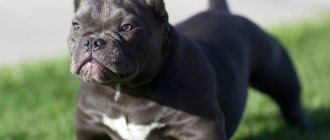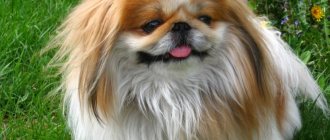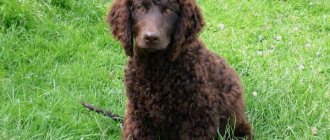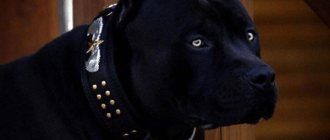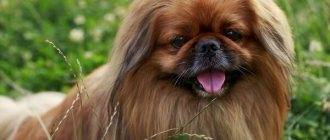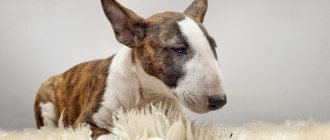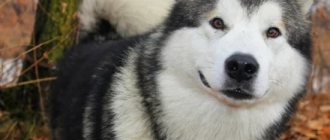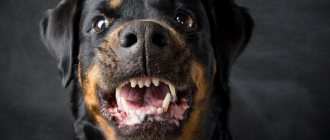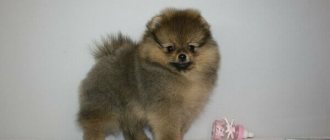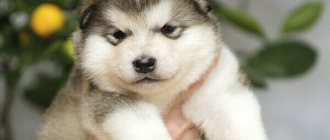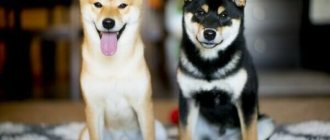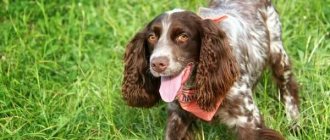Pit bull terriers, which have become almost synonymous with anger and aggression, are gaining more and more popularity.
Despite the mixed attitude of society, these dogs are characterized more as loyal friends and faithful companions than as ferocious and unbalanced dogs.
Those who love pit bulls, but cannot have such a pet because they live in a small apartment, should pay attention to their smaller copy - the mini pit bull.
Description of the breed and what it looks like in the photo
Mini pit bulls are dogs with a strong, stocky build, which makes them look bulky and powerful.
This build makes them unable to develop great speed, but in battle they compensate for this with the death grip of their powerful jaw..
- The body is rectangular, muscular, the back is straight and short with a smooth transition into a short loin. The chest is wide and voluminous, the ribs are rounded and arched.
- The belly is tucked in and connected to the chest by an almost straight line. The neck is short and thick, tapering towards the head, and the scruff is clearly defined.
- The head is wide and large, in the shape of a blunt wedge, proportional to the body. The skull is flat on top and rounded on the sides.
- Cheekbones and cheeks are emphasized and slightly saggy. If the animal grins or frowns, many skin folds form on the head. The size of the muzzle, slightly tapering towards the nose, is approximately equal to the skull, the lobe is black or colored to match the coat.
- The eyes are small, almond-shaped or round, set deep. The ears are set high and close to each other, erect at a natural length with the tips hanging down, but can be cropped.
- The limbs are short and powerful. The front ones are straight and strong, the shoulder blades are laid back and connect to the shoulders at a right angle, the rear ones are straight, set parallel and wide.
- The tail is short, set low, saber-shaped, not curled, not docked.
- The coat of dwarf pit bulls is short, thick and shiny, without signs of wavy, and lies tightly to the body.
Origin story. Marriage or breed?
Pit bull terriers are one of the most popular dog breeds in the United States, which have become the unofficial symbol of this country . Moreover, a country where at the beginning of the 19th century. The ancestors of these dogs were bred - Staffordshire Terriers - in Great Britain.
It was there that dog fighting flourished, creating a need for fierce and fearless dogs, stubbornly pursuing victory. After the ban on such bloody entertainment, representatives of this breed began to be used as simple guard dogs.
After some pit bull terriers arrived in the United States with immigrants, American breeders and breeders began improving the breed, paying maximum attention to the psyche of its representatives, trying to make them softer and kinder.
The next, even more daring, step of the breeders was the creation of a variety of pit bull terriers, distinguished not only by their gentle disposition, but also by their more compact size..
Painstaking work on crossing pit bulls with Patterdale terriers was crowned with success in 1990 - it was then that mini pit bulls were bred, which became lighter and shorter in stature, but retained strength, endurance and energy.
These dogs have not received official recognition from the FCI..
Interesting Facts
- Smaller version. Mini pit bull terriers are much smaller than ordinary pit bulls, but are in no way inferior to them in strength and endurance.
- Born hunters. "Pocket" pit bulls were used in hunting small game. This is where their dislike for other animals comes from. Genes take their toll.
- Why are pit bulls afraid? During the popularity of dog fighting, the image of pit bulls was severely demonized. The authorities hung posters of people torn to pieces, allegedly victims of this dog. This is how they tried to reduce the popularity of gladiatorial animal battles.
- Due to the rarity of the breed, the cost of its representatives reaches fabulous figures. A California breeder values his kennel's female micro pit bull, Queen Califia, at $50,000.
Character traits
Mini pit bulls can be described as good-natured, playful, loyal to their owner, but at the same time stubborn, wayward and strong-willed dogs.
They are strong and fearless and would make excellent watchdogs, but they are too friendly towards everyone, seeing strangers only as potential friends..
Moreover, if the owner or one of the family members is in danger, the mini pit bull will selflessly protect them, even if the enemy is much larger and larger than him.
Breeders have made a lot of efforts to get rid of the aggression towards other animals inherent in representatives of this breed, and they partially succeeded - these dogs get along with other pets easier than standard pit bulls, but they are still treated aggressively towards strangers.
Unlike standard pit bulls, the miniature variety, although highly active, is still calmer and more patient and more similar to other companion dogs..
Expert opinion
Kozhevin Semyon Kirillovich
Expert dog handler.
Miniature pit bulls are intelligent, trainable, and always eager to please their owner. They value care and need it, love communication and attention. Training is significantly complicated by their stubbornness and willfulness, therefore it is important to show persistence and show that the owner is an unconditional leader who must be respected and obeyed. Socialization is extremely important for these dogs; without it, they can grow up aggressive.
Development from 1 to 12 months
| Age | Size (height) | Weight | Description |
| 1 month | 20-25 cm | 2.5-4 kg | Immediately after birth, the puppy is almost completely dependent on its mother. Of all the reflexes, he only has: sucking, motor, olfactory and tactile. A newborn baby's ears and ears are closed, and there is no thermoregulation. By the end of the first month, the baby's eyes and ears open and he begins to actively explore the world, eat solid food and play with his fellow tribesmen. |
| 2 months | 25-30 cm | 6-9 kg | The 2nd month is called the period of first socialization. At this age, puppies are separated from their mother and find new owners. |
| 3 months | 30-36 cm | 9-14 kg | The baby is actively growing, gaining weight and changing significantly in appearance. At this age, the dog’s future exterior begins to be visible, the musculoskeletal system is actively developing and teeth begin to change. |
| 4-5 months | 35-45 cm | 14-24 kg | The pet grows and develops at a very fast pace, and a relationship between it and the owner begins to be established. At this age, the change of teeth is completed. |
| 6 months | 40-48 cm | 23-28 kg | Early adolescence. The puppy learns the meaning of the hierarchy and tries to find its place in it. At this age, pets can become stubborn and disobedient. Growth and development slow down by the end of the 6th month. |
| 7 months | 45-50 cm | 28-35 kg | The puppy begins to show sexual activity, and also tries to take the highest possible place in the domestic hierarchy. At this time, females are already in heat, and males become more active and can show aggression. |
| 8 months | 48-50 cm | 30-35 kg | At this age, the puppy increasingly takes on the appearance of an adult dog, and also begins to exhibit character traits that will be characteristic of it throughout its life. |
| 9-12 months | 48-50 cm | 30-35 kg | By this age, the pet’s body is almost completely formed. The exterior and character are also formed. If before this time it was not possible to teach the puppy the rules of behavior and commands, now it will be much more difficult to do so. |
Advantages and disadvantages
Advantages of mini pit bull terriers:
- friendliness;
- mind;
- ability to learn;
- courage;
- devotion;
- love for children;
- moderate shedding.
The disadvantages of the breed include:
- stubbornness;
- aggression towards other animals;
- the need for competent education and socialization.
In addition, these dogs are not suitable for street keeping or use as guard dogs.
Color variations
The coat of this breed can come in a variety of colors, be a solid color, or have lighter and white markings on the paws, neck and chest.
The most common and popular colors black , white and gray .
Diet
The diet of mini pit bulls can be based on natural products or industrial food - the choice depends on the dog owner. Both types of nutrition have pros and cons, so it is impossible to say unequivocally which one is better.
Thus, high-quality industrial feed, belonging to the premium, super-premium or holistic class, has a balanced composition enriched with vitamins and minerals, they are easy to use and dose, and can be stored for a long time.
At the same time, in case of an allergy to some component of the feed, a complete change of diet will be necessary.
NOTE!
Representatives of this breed are more suitable for food brands Eukanuba, Probalance, Pro Pac, Hill's, Royal Canin, Go.
Natural food requires more time to prepare food, but allows the owner to independently choose food for the pet and is safer when considering the risk of an allergic reaction.
The natural diet should include:
- offal;
- lean meat;
- veins and cartilage;
- sea fish;
- dairy products;
- vegetables;
- porridge.
It is forbidden to feed mini pit bulls:
- pickles, marinades;
- spicy and fried foods;
- sweets;
- milk;
- bakery and pasta products;
- potatoes.
With this type of nutrition, it is necessary to give the dog a vitamin and mineral complex.
Pet habits
The Hulk has a huge and at the same time incredibly kind heart - he loves to play with the sons of his owners, hug with Marlon and Lisa, and sing to the sound of a harmonica.
At the same time, such a good-natured expression is reflected on the dog’s face that, having seen at least one of his photographs, it is impossible not to fall under his incredible charm and not become one of the most devoted fans of this amazing beast.
IMPORTANT!
To maintain muscle tone and obtain the required amount of energy, Hulk must eat a lot of protein foods.
Typically, his daily menu consists of two kilograms of ground beef, to which some chopped vegetables, fruits or dairy products are added. In addition, the owners feed the world's largest pit bull with high-quality dry food.
Health and major diseases, life expectancy
The rather heavy build of miniature pit bull terriers causes them to often have problems with the heart and breathing; representatives of this breed often experience shortness of breath, so they have difficulty withstanding hot weather.
In addition, these dogs are susceptible to a number of hereditary pathologies, among which the most often diagnosed:
- heart disease;
- hypothyroidism;
- aortic stenosis;
- hip dysplasia;
- allergic reactions to food, certain medications, and external irritants such as pollen or insect bites.
Experts also say that mini pit bulls are susceptible to helminthiasis, so you need to carefully monitor what your pet eats and not neglect the timely use of anthelmintic drugs.
At the first signs of illness and symptoms of pathology, it is necessary to show the dog to a veterinarian.
The average lifespan of these dogs is 11-13 years.
How are children treated?
Although miniature pit bull terriers choose one owner, they love all family members, and are especially kind to children..
These dogs have a high pain threshold, so they tolerate children’s less-than-cautious attitude, expressed in pulling their ears or tail, easily and are not irritated.
Representatives of this breed are inquisitive and active, so fun and active games with kids bring them pleasure . These dogs become not only friends and nannies for children, but also loyal protectors.
Features of care
Mini pit bulls are dogs intended for home keeping..
They cannot live outside because they are sensitive to frost and heat. At the same time, living in an apartment or house, representatives of this breed need daily active walks.
Wool and bathing
The coat should be brushed weekly with a soft-bristled massage brush. After walks, you need to wash your pet's paws, and you should bathe him completely no more than once every 2-3 months to avoid drying out the hairs.
When bathing, you need to use a shampoo that is suitable for your dog’s coat type and make sure that foam and water do not get into the dog’s ears..
Teeth
To avoid the formation of plaque and tartar, brush your dog’s teeth twice a week with a special brush and toothpaste.
Eyes
Every morning, wipe with a lint-free cloth soaked in boiled water or chamomile infusion, making sure there is no strong souring and increased tearing.
Claws
Trim as it grows, approximately once every 3-4 weeks, with a guillotine nail cutter so as not to touch the living part and blood vessels.
Ears
Wipe weekly with a soft cloth soaked in a special lotion to remove accumulated wax and dust.
Mating
Females are allowed to breed no earlier than at the age of 18 months and only during the 3rd heat. Males occur at 16 months . The female should not give birth more than once a year .
The mother carries the puppies for approximately 2 months and 4 days (maybe a little more or less). She gives birth without outside help; in extreme cases, a caesarean section is performed. In one litter, from 3 to 8 puppies are born.
Training and education
During training, you cannot physically punish the dog or shout at it; commands must be pronounced calmly, but firmly and confidently, not allowing it to evade their execution.
It is better if the training takes place in a playful way and immediately after a walk, when the pet is tired enough and will no longer be distracted by external stimuli..
First you need to accustom the puppy to the nickname, calling him by name as often as possible. Afterwards, you should practice the “come to me” command, calling your pet when it is at a distance, but within sight.
Basic and necessary commands for mastering also include the commands “sit” (“lie down”), “no”, “wait” and “place”, and while walking you will need the command “near”.
To make care and maintenance easier, it’s a good idea to master the command “give me your paw” and develop your pet’s endurance.
IMPORTANT!
After each correctly executed command, the pet should be praised and treated with a treat - this helps to consolidate positive associations.
Hygiene
You don't need to bathe your pit bull puppy often. Exceptions are cases when he gets dirty in the mud or swims in a puddle. If the puppy is white, or just light-colored, it will be more noticeable when it's time for a bath.
When it comes to bath procedures, certain rules are followed:
- use puppy shampoo;
- water temperature not higher than 38°C;
- the puppy is rinsed with clean water to wash away any remaining soap, and then dried thoroughly with a dry towel;
- It is not recommended to dry wool with a hairdryer, but if there is such a need, use a weak blowing mode;
- after swimming they do not go outside for about 3 hours.
During and after bathing, make sure that the puppy is not exposed to a draft.
To maintain oral hygiene, you need to properly care for your teeth - for this you use a special paste and a brush, similar to a human one, or one that is put on your finger. The dog is gradually accustomed to this procedure, always starting with the far teeth on the outside.
The puppy's eyes should always be clean. If discharge appears, the eyes are washed or treated with special medications. If the discharge is permanent, consult a doctor.
Ears are cleaned every week. To do this, use a cotton swab and ear cleaner. It is important to regularly check your dog for ticks - they like to “cling” closer to the ears, jaw and neck.
Important! Under no circumstances should you use saline solutions or products containing alcohol to clean your ears.
How to choose?
Buying a puppy of this breed from a specialized nursery is not a whim, but a necessity . This is the only way to minimize the risk of acquiring a mixed breed or a sick animal.
In addition, breeders will provide all the necessary information about the parents of the future pet, talk about how to properly care for it and can guarantee that the puppy does not have genetic pathologies or developmental disorders.
You should not rush into choosing a dog and buy the first puppy you like . It is necessary to observe the behavior of children, to understand what character traits are inherent in them.
Thus, apathetic puppies that do not take part in the games of their littermates will most likely grow up calm and even lazy, but curious and active puppies will become energetic and playful dogs and will not lose these qualities even in adulthood.
It is also important to make sure your pet is healthy.
He should not have any rashes or irritations on the skin, a dull coat with traces of dandruff, a bloated belly, excess weight or exhaustion, discharge from the ears or nose, increased tearing or signs of sour eyes.
Pitbull temperament
There is an opinion that the purpose of the American Pit Bull Terrier is to organize dog fights. Many argue that this is perhaps the most aggressive breed. We hasten to reassure you: this opinion is groundless. In fact, the pit bull is a fairly calm and balanced animal that gets along well with other animals, as well as children. In addition, the pit bull breed has the following characteristics:
- dynamism;
- patience;
- energy;
- obedience;
- devotion.
The Pit Bull Terrier is a loyal dog that strives to help its owner in everything. This pet will not cause you problems, but only if you can provide the puppy with exciting leisure time at home from an early age and raise him correctly.
Price range
Miniature Pit Bull Terriers are hybrid and quite rare dogs that were bred just a few decades ago.
The popularity of this breed and the growing demand for its representatives have led to the emergence of a mass of unscrupulous breeders, so you should buy a puppy only in specialized nurseries, of which there are very few in the CIS countries, or order from Europe or the USA.
The cost of a mini pit bull puppy is at least 15 thousand rubles. and increases depending on its class, and in the case of an order from another country, the cost of shipping the dog will be added to this price .
Vaccination
Vaccinations are given to pit bulls throughout their life, starting at 8–10 weeks. The first vaccination at this age is a comprehensive vaccination against distemper, hepatitis, adenovirus infection, parainfluenza, parovirus enteritis and leptospirosis.
At 12 weeks, a second vaccination is given. At six months the puppy is vaccinated against rabies, and after another six months all vaccinations are repeated.
After this, they go to the veterinarian annually for revaccination against all the diseases mentioned.
